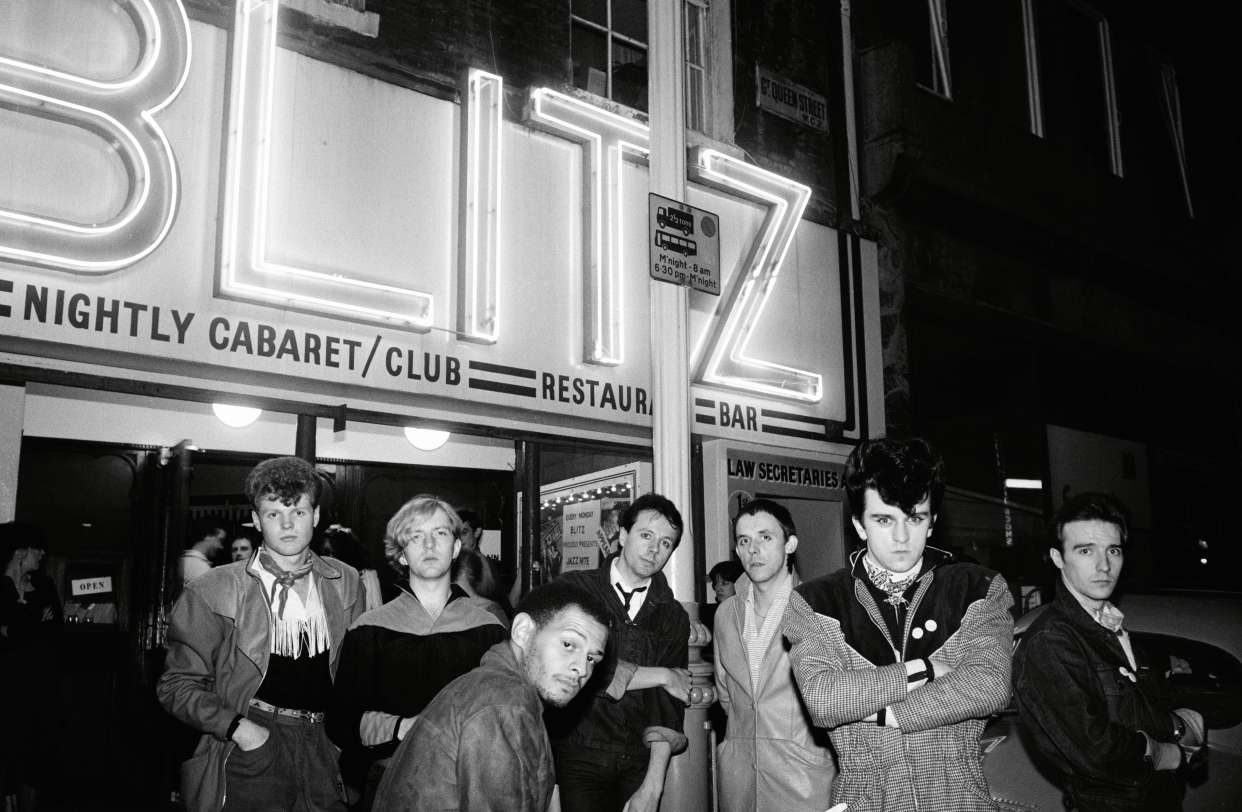Visage outside Blitz nightclub … Sheila Rock’s best photograph

In the 1970s, when I first came to Britain from America, London life was dreary and grey. But then came glam rock and after that punk, which was dark yet flamboyant in a different way. By the early 80s, there was still no money around but there was a feeling of can-do optimism and freedom. The people at the Blitz, a club at Covent Garden, were the movers and shakers of the New Romantic era. I was fascinated by them.
This picture was taken right at the start of the 80s. I knew Steve Strange, Rusty Egan and Midge Ure – who were then part of the band Visage. The Blitz sign was striking and I thought it would make a strong background for a photo of the band. Steve is in the front with big hair, looking straight into the camera. His magnificent fashion transformations were a daily occurrence. Street fashion was at its peak – the pavements and nightclubs were like catwalks – and it was the beginning of gender experimentation and a sexual revolution that’s still resonating today. Inside the club, you had a cast of characters from Boy George to Marilyn. Everyone was dressing up: you could be whatever you wanted. Once you discover glitter, it is hard to go back to bland. It was like a dream, a fantasy land.
Inside, you walked through a narrow tunnel to a cavernous space with a dancefloor. Rusty had his DJ equipment on one side and the club would play Kraftwerk, Yellow Magic Orchestra and bands a lot of mainstream radio would never feature. It was the era of music made with technology: drum machines and synthesisers. Punk was working class in its roots, but early 80s music drew people from the art colleges. Dressing up was about creative, artistic expression. There was a certain elitism to it: if you didn’t look good, you weren’t allowed in. For a photographer, it provided a total visual experience. I just had to point my camera and a parade of extraordinary people would pass by.
I was introduced to rock’n’roll by David Bowie, who I photographed in the 1970s. I was married to photographer Mick Rock and David invited us on his first US tour, which began in 1972. He was promoting his album The Rise and Fall of Ziggy Stardust and I went along with innocent eyes. It was a magical mystery tour, with musicians like Iggy Pop and Lou Reed popping in. At the end of it, I was invited to go to the CBGBs club in New York where I was introduced to the likes of Debbie Harry and Richard Hell: punks before punk was really happening. Malcolm McLaren had come to the city, met the New York Dolls, then brought punk consciousness back to the UK. I was at the right place at the right time.
I photographed many innovative bands: Bauhaus, Japan, Pet Shop Boys, Cocteau Twins and many more. It was an extraordinary time, all about youthful creativity and expression. But all things move on. Like punk, the New Romantic period will never be repeated. I look back on the decade fondly. It was the beginning of my photographic career, of experimenting and meeting extraordinary people. There was a lot of hope, with a new energy on the streets. Towards the end of the decade, it became about brands and corporate-thinking, less individual and more commercial, which was disheartening. I began working in a more commercial way myself, mainly in fashion. But this photo of the Blitz and the New Romantics represents a flamboyance that emerged from a dark time. It was an era like no other. It was a celebration.
• 80s Sound and Vision by Sheila Rock is published on 20 September by Frances Lincoln (£32).
Sheila Rock’s CV
Born: Chicago.
Trained: Boston University, London Film School, and self-taught.
Influences: Bruce Davidson, William Klein, Irving Penn.
High point: “Seeing my formative music work displayed in a hangar-sized gallery, the Power Station of Art in Shanghai. Giant photos from my book Punk+ decorated its walls. Amazingly, this was sponsored by the Chinese government.”
Low point: “Rolls of film from a prestigious Marks and Spencer shoot were destroyed because the lab technician fell asleep on the job. I never worked for them again.”
Top tip: “Always try to be open to the moment. Look for the unusual. Mistakes may lead to the best results. A great shot is often a misstep in the right direction.”

 Yahoo News
Yahoo News 
